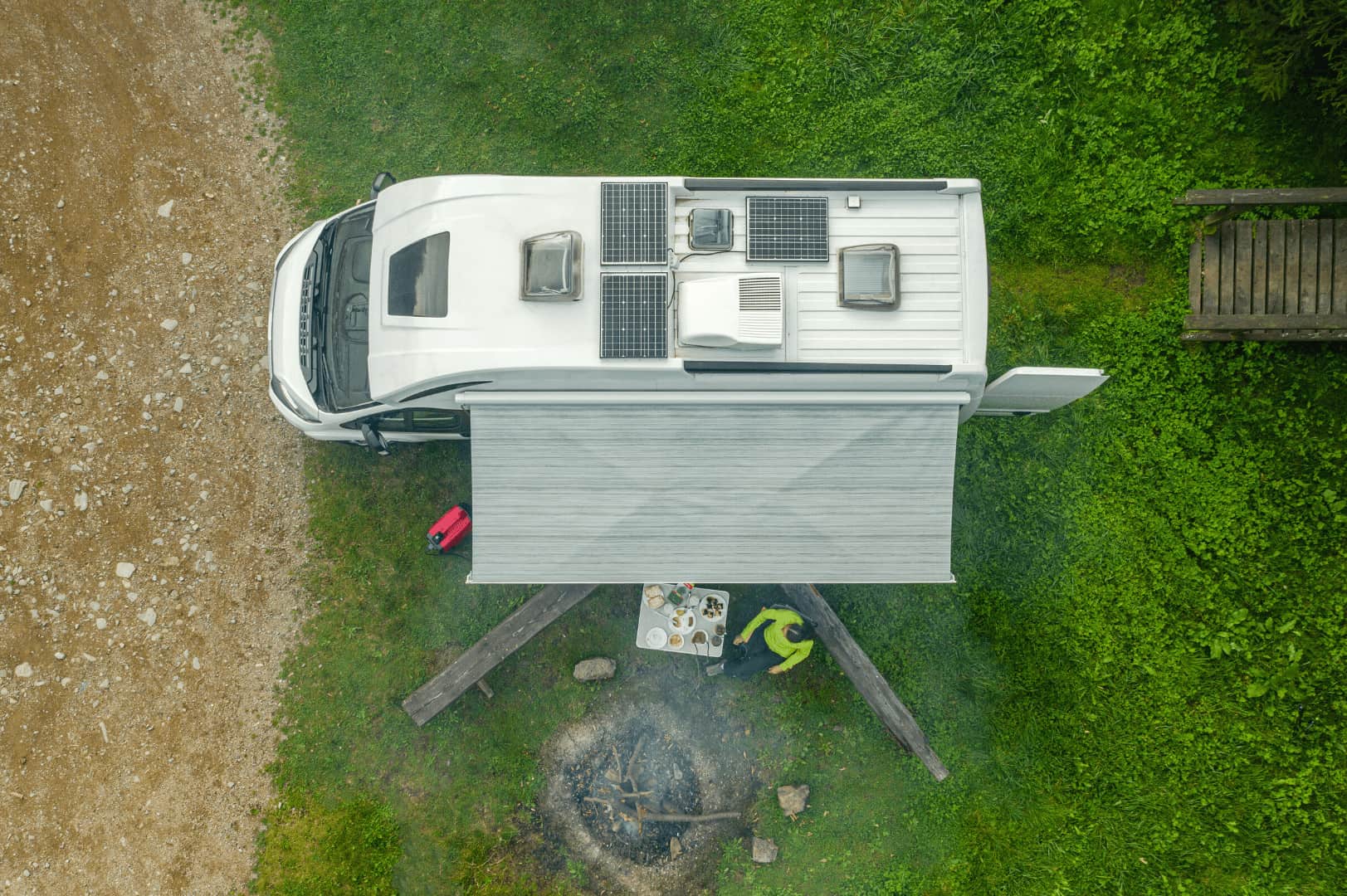Perfectly predicting the weather for your motorhome trips is hard to accomplish. This is especially true in the UK, where blazing sunshine and heavy rain can occur in the space of a single day.
Because of this, we think motorhome awnings are essential accessories – you’ll certainly be grateful if you’re caught in unforeseen weather conditions on your trips.
What’s more, an awning significantly increases the amount of living space you have available while camping. This is the case for all the different types of motorhome awnings, which include:
- Fixed
- Driveaway
- Retractable canopy (manual or electrical wind out)
Yet regardless of which kind of awning you use, you need to take good care of it as a part of your wider motorhome maintenance activities. In this article, we’ll explain the most essential motorhome awning care tasks in detail.
Tethering your awning
It’s crucial you secure your awning firmly to the ground to safeguard it against strong winds. Strong winds can blow your awning up and over your motorhome. This causes serious damage, not only to the awning itself but also to your motorhome’s roof.
While every type of awning can experience damage due to strong winds, it’s especially likely for canopy awnings – which, owing to their minimalistic structures and fixtures, don’t tend to have as much stability as the other kinds of awnings.
In the following sections, we’ll focus on explaining how to tether a canopy awning. Yet much of the tethering advice below also applies to fixed and driveaway motorhome awnings.
Fixing ground pegs
Ground pegs provide the grip that keeps your awning firmly rooted into the ground. There are many kinds of pegs you can use to tether your motorhome awning, including:
- Bent wire pegs
- V-shaped steel pegs
- T-shaped plastic pegs
- Rock pegs
- Screw-in pegs, inserted with a drill or impact driver
We’d recommend avoiding bent wire pegs as they’re easily bent out of shape during insertion. They also typically don’t provide as much stability as the other kinds. While the first four kinds are relatively easy to insert with a rubber mallet, screw-in pegs are the most convenient to use – provided you have the appropriate power tools available.
Whichever type of peg you opt for, insert them into the ground about a meter or so away from each outer corner of the awning, at a 45-degree angle. You should also try to give the pegs a slight angle of insertion into the ground, leaning directly away from each awning corner. This means that when the wind eventually pulls against the straps, it’s less likely to pull the pegs over and out of the ground as they’re leaning against the line of pull.
At the very least, you’ll need to fix two pegs into the ground – one to strap to each outer corner of your canopy awning. But if you have a fixed or driveaway motorhome awning, you might want to use more pegs to accommodate its larger size.
Attaching tie-down straps
Sometimes also called hold-down straps or storm straps, these durable lengths of fabric provide a strong connection between the pegs and your awning.
Many canopy awnings come with a track on their outer edge that allows you to hook on the straps. Other models have holes at the top of their poles where you hook the straps instead. If in doubt, always refer to your awning manual to find out where it’s designed to receive the tie-down straps.
Once you’ve attached one end of a strap to the awning, you’re ready to hook the other end to one of the pegs you’ve already fixed into the ground.
For extra stability, we’d recommend you use straps together with springs. Attached between the bottom end of a strap and a ground peg, a spring will absorb much of the tension created by strong winds – reducing the stress experienced by the straps and awning canopy themselves.
Creating tension
Once you have two straps attached to the outer corners of your awning at one end and to the ground pegs at the other, you can now adjust them until they’re nice and taut.
Most tie-down straps are adjustable, featuring either a buckle or ratchet mechanism. Yet just in case your straps aren’t adjustable for some reason, you can create tension by adjusting the distance of the ground pegs from the awning.
When you’ve finished adjusting the straps, you should be able to feel tension running all the way from the ground, along each strap, and throughout the fabric of your awning. Moreover, the awning poles should feel firmly planted into the ground.
How to clean your motorhome awning
If you want to keep your awning in good working condition, you need to clean it regularly.
The simplest way to do this is while it’s set up for use. This will mean that the canopy will already be taut, as well as any panels or privacy room walls you might be using. For this reason, we’d recommend cleaning your awning before you pack it away so it’s clean and ready for the next time you want to use it.
Bear in mind that it might be easier to clean the top of the awning canopy last, after removing any poles on the side furthest from your motorhome – or deflating them if you have an inflatable motorhome awning. If your awning doesn’t use poles in its structure, you can use a step ladder to get to a suitable height as an alternative.
In general, you can clean the fabric of your awning using the following steps:
- Remove any dirt and grime with a stiff brush
- Clean the fabric with a suitable cleaning agent: to avoid damaging the awning’s waterproofing ability, be sure to read the instructional manual to find out which cleaning agents are recommended
- Rinse thoroughly with clean water
- Allow your awning to dry naturally
Reproofing your motorhome awning
Whether your awning is made of canvas or acrylic material, the time will come when you need to treat it so that it can retain its waterproofing ability.
Since these two types of material use different mechanisms to keep out water, you’ll need to use a different reproofing agent on each. Again, the most important thing to do is read your awning manual to find out the type of material of which it’s made and which type of waterproofing agent your awning provider recommends.
Before you begin reproofing, you need to ensure that your awning is completely clean and dry. Then, proceed with the following steps:
- Fit your awning to your motorhome’s rail
- Peg out the awning so that the walls are taut
- Evenly apply the reproofing agent on the awning’s fabric
- Allow your awning to dry, before folding it away and storing it
How to clean awning groundsheets
You’ll also need to clean the groundsheet that you use to keep the underside of your awning protected and dry.
You should be able to do this using basic household cleaning supplies – as long as you don’t use any strong detergents or harsh chemicals. To be on the safe side, though, simply check which cleaning agents the manufacturer recommends in the groundsheet manual.
Before you can begin cleaning your groundsheet, you need to fix it in place using ground pegs. This will help to prevent the groundsheet from moving as you clean it. Once this is done, you can begin the following cleaning steps:
- Remove any dried dirt and debris with a brush
- Wipe it down with a sponge and cleaning agent
- Rinse it off with water
- If necessary, mop up any excess water
- Flip your groundsheet over and repeat steps 1-4 on the other side
- Finally, hang your groundsheet from a washing line and allow both sides to dry
It’s important you let your groundsheet dry completely. Otherwise, when you get it out of storage you might find that dampness, mould or mildew have set in – the odour of which isn’t conducive to an enjoyable camping experience.
Motorhome awning storage
When you’re storing your awning kit, it’s the perfect opportunity to ensure it’s ready to perform for you the next time you need to use it. You can do this by carefully inspecting it as you pack it away. Examine all components, including:
- Fabric
- Poles
- Pegs
- Guy lines
- Seams
- Zips
- Windows
- Vents
- Groundsheet
Take note of any damage you find. Even if you aren’t able to repair your awning at that particular moment, you’ll at least know what you need to fix before the next time you use it.
Make sure that you store it in a cool and dry place so it doesn’t develop any mildew or mould. You should also make sure that it isn’t in direct sunlight, as this can slowly degrade the fabric over time.
Get motorhome insurance that protects your awning
An awning is a significant investment for your motorhome. By giving it the right amount of care and attention, you can improve the chances of it staying in good working condition.
There are some situations, however, in which even the most diligent care won’t be enough to safeguard your awning. That’s when having motorhome insurance that covers awnings can help to bring you peace of mind.
At Comfort Insurance, our motorhome policies cover your fixed awning in the event that it’s lost or damaged due to an accident, fire or theft while attached to your motorhome. If you’d like to find out how we can help protect your home away from home, contact us by calling 0208 9840 666 or emailing us at info@comfort-insurance.co.uk.







